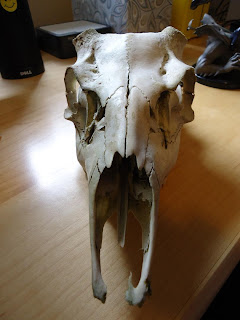
A friend at work gave me the skinned head of a [blank] that he had trapped. He wanted to see what I could do with it. Having already, years ago, did nice skullifications on wolf, deer, and pig heads, I was eager to try my hand at the hobby once more. This is where I'm at. The boiling...the stench...I'm glad it's over.

Obviously, it's an Alaskan animal. Not very big skull, though. There are some structures towards the back of the skull here in ventral view that are dead giveaways.

Big goddamn fangs!

Here's the mandible. Again, big fangs and very reduced dentition. This critter wasn't doing a lot of chewing, but plenty of cutting and slashing. I would not want to be caught in a room with this bugger.

Here's a dorsal view of the mandible, if that helps (probably not).
While in Kodiak last weekend, I found this beauty sitting by the road. At one point, one half was lying in the ground (you'll see) as it was covered in dirt and moss. I've managed to pick most of it off. It's in really gorgeous condition, though.

I know what it is. Do any of you? Again, obviously, Alaskan.

"Why the long face?"

This is the mossy side. It's greener than the other half, but otherwise in the same condition.

As you can see, the only broken bone is the right "prong" process that points downward at the back of the skull. These prongs are helpful in keeping the skull standing up, so with one missing it tends to tip over.
Can't complain too much, though--it's not every day you find a really well-preserved skull just sitting by the side of the road. After the lynx is done (gotta get the brains and sinus tissue out), I've got a big mallard duck in my freezer ready for plucking, skinning, and skeletizing!




6 comments:
The first one is a kitty of some variety. It doesn't look big or robust enough to be a puma. Maybe a lynx or a bobcat? Way up there, probably the former, I would think.
The second one looks like it might be [Rangifer]. It doesn't look like it has a fleshy enough schnoz to be [Alces].
It's a little hard to tell without much to base the scale on, but I'm guessing the first critter is some kind of mustelid and agreeing that the second is a cervine.
Let's see if these tags work (I'll bet they don't): The top skull is a [spoiler]adult female lynx[/spoiler] and the second skull is a [spoiler]black-tailed deer[/spoiler].
So you're both pretty correct.
That's cool. I love skulls, man, and I saw some of your posts. They're a bit unusual, but they're cool.
You might want to try bacterial maceration. Just submerge your item to be skeletonized in water, seal the container and leave it in a warm place. Depending on the warmth and bacterial activity, full cleaning can be obtained in days or years. Sterilize in a solution of hydrogen peroxide and water. Degrease by soaking in Pine Sol or equivalent.
The first is clearly a cat of some kind -- thin, blade-like molars for cutting meat, and no grinding molars at all. Also, the whole face is short. Bobcat? Lynx?
If you're going to clean skulls often, set up a dermestid beetle colony. If well cared for and the bones to clean are well dried, it will have little odor. It's slow, of course.
Post a Comment